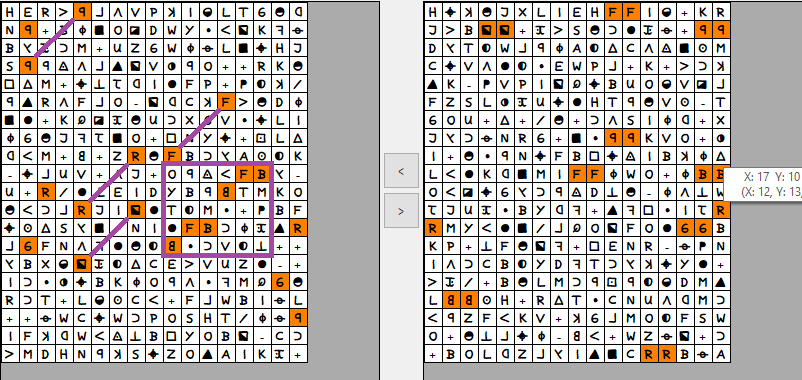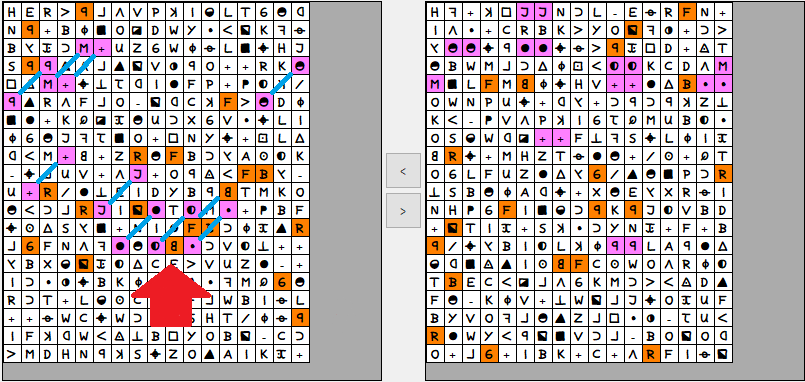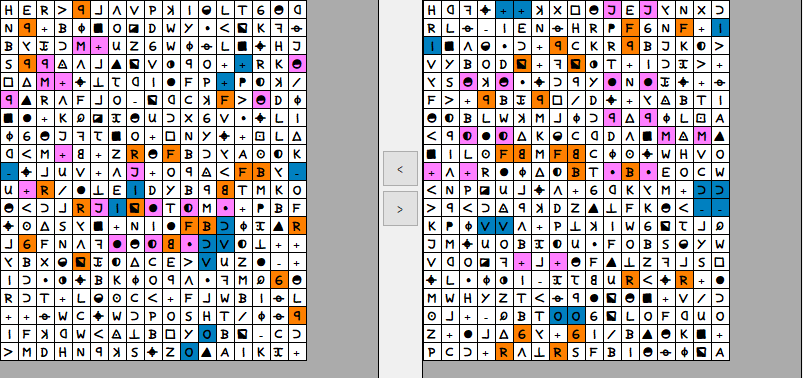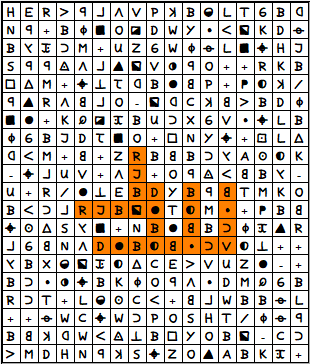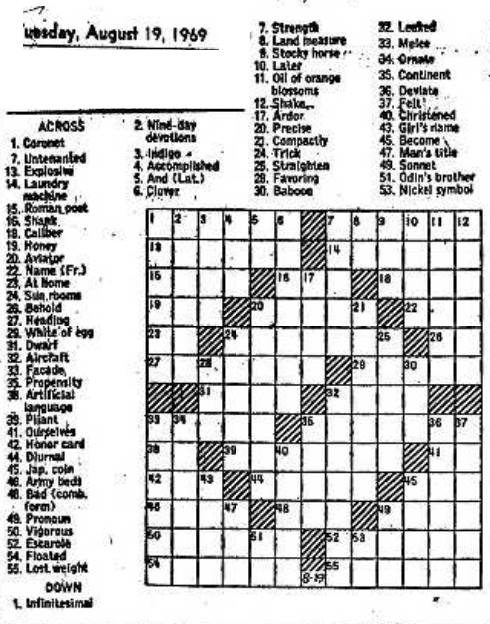I had a weird idea –
What if the plaintext was actually just a drawing or pattern made with regular letters?
Something like this simple 17×20 example, but maybe with more detail to account for the variety of symbols:
I think that is a really cool idea too. I was thinking something similar in the last few days, wondering if, instead of a message, letters of the alphabet are repeated in some type of pattern that makes a whole lot of pivots, and after diffusion two show through. Or a shorter message that is repeated over and over in a pattern that does the same thing.
Cool idea! Do you happen to have a text version?
Sure:
................. ........X........ ........X........ ......XXXXX...... ....XX..X..XX.... ...X....X....X... ...X....X....X... ..X.....X.....X.. XXXXXXXXXXXXXXXXX ..X.....X.....X.. ...X....X....X... ...X....X....X... ....XX..X..XX.... ......XXXXX...... ........X........ ........X........ ........X........ ................. ................. .................
If you squeezed two small crosshairs symbols in there, the axes of each one would contribute to pivots.
I have an idea for an experiment that I will consider. Make 1000 messages that are 170 letters long, and make as many 3×3 pivots as possible by reflecting 3 letter segments of the message L shape. Then diffuse with 63 symbols and see how many messages have two or more pivots. It would be the ultimate baseline test.
If Zodiac stumbled across an article on Steganography we could be screwed…
I’ve always thought the idea of a crossword made since. He fills it in in a somewhat non-tricky manner, giving the pivots because maybe kill crosses kill or something like that.
I had a weird idea –
What if the plaintext was actually just a drawing or pattern made with regular letters?
Something like this simple 17×20 example, but maybe with more detail to account for the variety of symbols:
I think it’s a great idea! Eons ago I had also experimented with a Cross-Hair symbol, similar to your example. However, I had used the X’s as a filler. I drew the Cross-Hair symbol once as a circle like you and once as a square. I also tried to arrange the 24 plus symbols in z340 into a similar pattern. All without any notable success.
Splitting the homophones exclusively between the Dots and the X’s is really a cool idea. I can well imagine that such an approach would leave quite strange features in the final cipher. I spontaneously think of the feature "unique sequence length" as well as the pivots. It’s raining a lot at the moment, so I might find some time to do some experiments =)
I have an idea for an experiment that I will consider. Make 1000 messages that are 170 letters long, and make as many 3×3 pivots as possible by reflecting 3 letter segments of the message L shape. Then diffuse with 63 symbols and see how many messages have two or more pivots. It would be the ultimate baseline test.
I’m afraid I don’t quite understand. Are you referring to an common plain text that you squeeze into as many pivots as possible, or to a pattern?
Some days ago Jarlve wrote:
Excuse my language but basically the pivots are the most retarded observation in a cipher, ever.
(From thread: viewtopic.php?f=81&t=4461&p=73507#p73507)
This statement had inspired me to experiment with the pivots again. I did have some interesting results, but most of them have either been mentioned in the past or seemed coincidental to me. Due to the current thread I would like to show the results nevertheless, perhaps still something arises:
The "flanks" of the pivots basically consist of repeated characters (hereafter called "doublets") on P16, P32, and P48, respectively. So I untransposed z340 with P16, P32 and P48 and marked all doublets. It looks like this:
Left P1, right P48
The half filled squares, which are connected to the left pivot, and the F’s, which are directly in line with the right pivot, are conspicuous. I also find the pattern in the marked square interesting.
Left P1, right P32
The pattern from filled square, half filled square and dot is not new, but it cries out for attention. Read more about it later.
Left P1, right P16
Exactly at the junction of the right pivot there is also an interesting pattern (mirrored C’s and the two V’s).
To cut a long story short: Could the marked doublets be incomplete pivots? I followed this question and experimented a little bit more. If the pivots are incomplete, then you should be able to merge the symbols that don’t match.
-> Since only three pictures can be posted, I’ll show the result in the next posting…
I hope you can see what’s meant. It is important to merge only P16 with P16, P32 with P32 and P48 with P48. Of course there are a lot of possibilities to merge symbols and to create incomplete pivots. A good clue are collisions when merging. If you create a new pivot and destroy an existing one, then one of the two presumed pivots is not a pivot.
Does anyone have an idea how to automate something like this? Is it worthwhile to start a test here at all?
As a counter test, I created some ciphers with two pivots pointing in the same direction with my Cipher Factory. Then I marked the doublets again. Although there were some similar patterns as shown above, none of the experiments had so many possible incomplete pivots right next to the actual pivots.
Maybe we’re really dealing with a pattern?
PS: November marks the fiftieth anniversary of the release of z340. If Zodiac is still alive and enjoying it, it would be great to spoil this anniversary by solving z340.
Translated with http://www.DeepL.com/Translator
Very interesting ideas, Largo!
My approach to automating would be to build a hillclimber for it. It would have some way to merge symbols from candidate incomplete pivots to form complete ones. Then it would count the total number of complete, intact pivots, and try to maximize the count.
But maybe a brute force search is possible, since there is a limited number of candidate incomplete pivots. Then you could pick the set of merges that produced the largest count of completed pivots. If that’s possible, then the count would be a good way to measure how "susceptible" Z340 is to these partial pivots, vs shuffled ciphers or other test ciphers. It also leads to the question: Should the search include pivots in different orientations?
I’d enjoy working on such an algorithm but I doubt I’ll ever get time in the near future. ![]()
(A second algorithm that’d be fun to explore would be: Build a hillclimber that merges pairs of symbols. The score would be a measurement of the symmetry of the resulting cipher, measured about some arbitrary point or axis. Is Z340 more susceptible than other ciphers to symmetry by the end of this search?)
What about this idea. If there was an inscription or transposition that makes a lot of pivots ( I am experimenting with one now which seems to work well ), and only two of the several pivots are shining through. And then try to merge symbols to see if there is some way to allow for the other pivots to shine through. And then that might show the inscription or transposition. A solver that scores pivots instead of ngrams.
viewtopic.php?f=81&t=3196&p=70912&hilit=pivots#p70912
Largo: I mean a message something like this that makes as many pivots as possible in the plaintext before diffusion. Then see how many pivots shine through after diffusion. One thought that I have to add is Jarlve’s recent cycle experiments show that the first half is closer to 15% random, and the bottom half is 35% random. Maybe with cycles, less randomness allows for fewer pivots and vice versa, and the pivots are mostly in the bottom half of the message.
I agree that we could be dealing with a pattern.
"Text Art" or "ASCII Art" is actually a thing. I found it on Google. People make all kinds of pictures with letters, but most of the stuff I found looks pretty contemporary and computer generated. I wonder if this kind of text art existed in the 1960s or if there are any text art pictures in actual Zodiac related images or comic books, etc.
Example of "art typing":
The Morning Call
Paterson, New Jersey
23 Apr 1948, Fri • Page 10

Arizona Republic
Phoenix, Arizona
21 Aug 1966 • Page 65
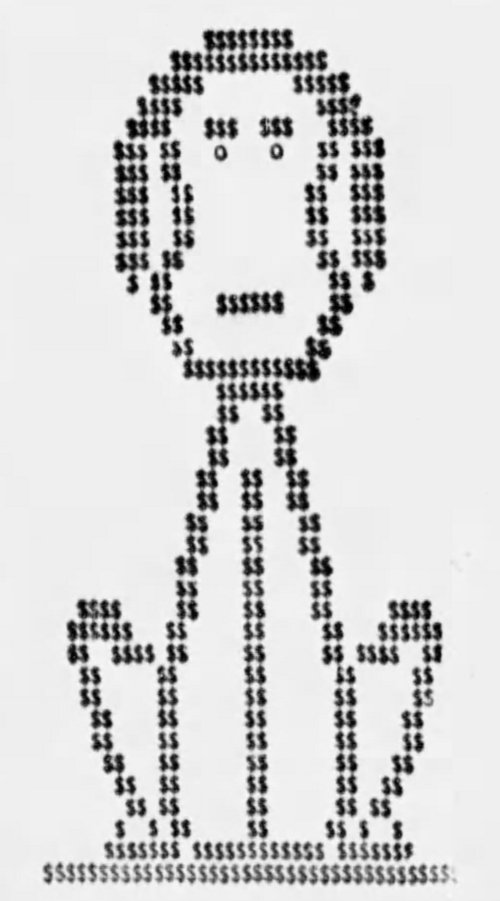
Results of a typewriter art contest:
http://zodiackillerciphers.com/images/A … _1966_.jpg
Wow, thanks doranchak and Cragle. The typewriter art and cross word puzzle pictures are very interesting.
Typewriter art contest. Awesome.
I don’t believe in the pivots or something advanced. I would guess that if the cipher is double encoded in some way. Then the message is a simple scramble then encoded.
For instance. Can any of the tools crack a cipher if the message is first scrambled with the robber language? There are other nordic references from the Zodiac and robber language is known in the nordic countries.
https://en.wikipedia.org/wiki/R%C3%B6varspr%C3%A5ket
(My tests indicated that the Z340 is not in the robber language. If it is correctly encoded.)
But maybe a brute force search is possible, since there is a limited number of candidate incomplete pivots. Then you could pick the set of merges that produced the largest count of completed pivots. If that’s possible, then the count would be a good way to measure how "susceptible" Z340 is to these partial pivots, vs shuffled ciphers or other test ciphers.
Thanks for the ideas. I think I’ll try Brute Force first. You’re right, there are only a few candidates in z340, but theoretically merging symbols could create more candidates. However, the search space remains quite small. Let’s see what comes out of these experiments. However, it will take a little while until I have implemented this.
It also leads to the question: Should the search include pivots in different orientations?
Definitely! At first I will limit myself to one direction only and see what comes out of it. Then I will look at several directions. In this way, for example, crosshairs could form. It is exciting in any case.
smokie:
Thanks for the explanation. That looks interesting. Such a thing really could be responsible for the pivots. I wonder if P19 can be explained with it, too.
Translated with http://www.DeepL.com/Translator
